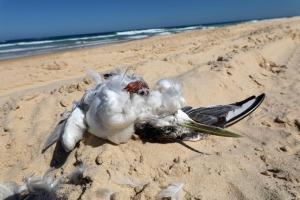车辆杀死沙滩上的鸟类:全球证据
IF 8
1区 环境科学与生态学
Q1 ENVIRONMENTAL SCIENCES
引用次数: 0
摘要
1.海洋海滩为各种鸟类觅食、繁殖和栖息提供了必要的栖息地。海滩也可以成为机动娱乐的主要场所,在那里,越野车(orv)与鸟类相互作用——这在人类与野生动物领域创造了一个复杂的威胁景观,转化为一个邪恶的保护挑战。因为有效的车辆管理旨在减轻orv对动物的不利影响,理想情况下,基于证据,在这里我们综合了全球沙滩上车辆与鸟类冲突的数据。我们的荟萃分析表明,orv对海滩鸟类的有害影响在地理上是广泛的,以多种方式影响着物种的多样性,对个体、种群和群落都造成了严重的伤害。受orv胁迫的鸟类的丰度和多样性显著下降是很常见的。在繁殖周期的所有阶段,适合度都受到损害:a)在对orv开放的海岸上,繁殖对、巢穴和成功的繁殖尝试都减少了;B)不良的孵化行为使蛋和雏鸟暴露于热、冷和捕食者;C)巢和蛋直接被车辆压碎;D)孵出的小鸡越来越少,e)羽翼丰满的雏鸟数量减少。orv还会冲红鸟类(“在翅膀上逃跑”),缩短关键的觅食时间,造成生理压力,并将个体转移到不太有利的栖息地。越野车造成严重生态危害的有力证据明确表明,有必要永久性地减少orv的空间范围,在各种海景和人类使用环境中为沿海鸟类创造适当大小的“安全区”。本文章由计算机程序翻译,如有差异,请以英文原文为准。

Vehicles kill birds on sandy beaches: The global evidence
- 1.Ocean beaches provide essential habitats for a diversity of birds to forage, breed, and roost. Beaches can also be prime sites for motorized recreation where off-road vehicles (ORVs) interact with avifauna - this creates a complex threat landscape in the human-wildlife domain, translating into a wicked conservation challenge.
- 2.Because effective vehicle management aimed at mitigating the adverse impacts of ORVs on animals is, ideally, evidence-based, here we synthesize the global data on vehicle-bird conflicts on sandy beaches.
- 3.Our meta-analysis demonstrates that deleterious impacts of ORVs on beach birds are geographically widespread, impacting a diversity of species in multiple ways, representing serious harm to individuals, populations, and assemblages.
- 4.Significant declines in the abundance and diversity of birds stressed by ORVs are common. Fitness is compromised at all stages of the breeding cycle: a) there are fewer breeding pairs, nests and successful breeding attempts on shores open to ORVs; b) compromised incubating behaviour exposes eggs and chicks to heat, cold and predators; c) nests and eggs are directly crushed by vehicles; d) fewer chicks hatch, and e) the number of young fledged diminishes. ORVs also flush birds (‘escape on the wing’), curtail critical foraging time, cause physiological stress, and displace individuals to less favourable habitats.
- 5.The strength of the evidence for serious ecological harm unambiguously attributed to off-road vehicles emphasizes the need to permanently reduce the spatial reach of ORVs, creating adequately-sized ‘safe zones’ for coastal avifauna in a variety of seascape and human use settings.
求助全文
通过发布文献求助,成功后即可免费获取论文全文。
去求助
来源期刊

Science of the Total Environment
环境科学-环境科学
CiteScore
17.60
自引率
10.20%
发文量
8726
审稿时长
2.4 months
期刊介绍:
The Science of the Total Environment is an international journal dedicated to scientific research on the environment and its interaction with humanity. It covers a wide range of disciplines and seeks to publish innovative, hypothesis-driven, and impactful research that explores the entire environment, including the atmosphere, lithosphere, hydrosphere, biosphere, and anthroposphere.
The journal's updated Aims & Scope emphasizes the importance of interdisciplinary environmental research with broad impact. Priority is given to studies that advance fundamental understanding and explore the interconnectedness of multiple environmental spheres. Field studies are preferred, while laboratory experiments must demonstrate significant methodological advancements or mechanistic insights with direct relevance to the environment.
 求助内容:
求助内容: 应助结果提醒方式:
应助结果提醒方式:


